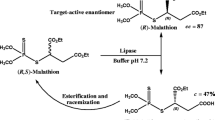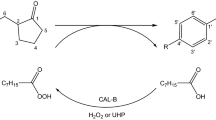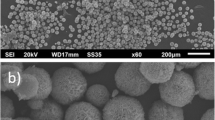Abstract
Optically active form of α-cyano-3-phenoxybenzyl (CPB) alcohol, building block of pyrethroid insecticides, was synthesized as its acetate by the combination of anion-exchange resin (D301)-catalyzed transcyanation between m-phenoxybenzaldehyde (m-PBA) and acetone cyanohydrin (AC), and lipase (from Alcaligenes sp.)-catalyzed enantioselective transesterification of the resulting cyanohydrin with vinyl acetate. Through optimizing technological conditions, the catalyzing efficiency was improved considerably compared to methods previously reported. Concentrations of CPB acetate were determined by gas chromatograph. The enantio excess (e.e.) values of CPB acetate were measured by NMR (nuclear magnetic resonance) method. Effects of solvents and temperatures on this reaction were studied. Cyclohexane was shown to be the best solvent among the three tested solvents. 55 °C was the optimal temperature for higher degree of conversion. External diffusion limitation was excluded by raising the rotational speed to 220 r/min. However, internal diffusion could not be ignored, since the catalyst (lipase) was an immobilized enzyme and its particle dimension was not made small enough. The reaction rate was substantially accelerated when the reactant (m-PBA) concentration was as high as 249 mmol/L, but decreased when the initial concentration of m-PBA reached to 277 mmol/L. It was also found that the catalyzing capability of recovered lipase was high enough to use several batches. Study of the mole ratio of AC to m-PBA showed that 2∶1 was the best choice. The strategy of adding base catalyst D301 was found to be an important factor in improving the degree of conversion of the reaction from 20% to 80%. The highest degree of conversion of the reaction has reached up to 80%.
Similar content being viewed by others
References
Bedell, B.A., Mozhaev, V.V., Clark, D.S., Dordick, J.S., 1998. Testing for diffusion limitations in salt-activated enzyme catalysts operating in organic solvents.Biotech. & Bioeng.,58(6):654–657.
Carrea, G., Riva, S., 2000. Properties and synthetic applications of enzymes in organic solvents.Angew. Chem. Int. Ed.,39:2226–2254.
Halling, P.J., 1994. Thermodynamic predictions for biocatalysis in nonconventional media: theory, tests, and recommendations for experimental design and analysis.Enzyme Microb. Technol,16:178–206.
Inagaki, M., Hiratake, J., Nishioka, T., Oda, J., 1991. Lipase-catalyzed kinetic resolution with in situ racemization: one-pot synthesis of optically active cyanohydrin acetates from aldehydes.J. Am. Chem. Soc.,113:9360–9361.
Inagaki, M., Hatanaka, A., Mimura, M., Hiratake, J., Nishioka, T., Oda, J., 1992a. One-pot synthesis of optically active cyanohydrin acetates from aldehydes via quinidine-catalyzed transhydrocyanation coupled with lipase-catalyzed kinetic resolution in organic solvent.Bull. Chem. Soc. Jpn.,65:111–120.
Inagaki, M., Hiratake, J., Nishioka, T., Oda, J., 1992b. One-pot synthesis of optically active cyanohydrin acetates from aldehydes via lipase-catalyzed kinetic resolution coupled with in situ formation and racemization of cyanohydrins.J. Org. Chem.,57:5643–5649.
Klibanov, A.M., 1990. Asymmetric transformation catalyzed by enzymes in organic solvents.Acc. Chem. Res.,23:114–120.
Klibanov, A.M., 2001. Improving enzymes by using them in organic solvent.Nature,409:241–246.
Phillips, R.S., 1996. Temperature modulation of the stereochemistry of enzymatic catalysis: prospects for exploitation.TIBTECH,14:13–16.
Valivety, R.H., Halling, P.J., Macrae, A.R., 1992. Reaction rate with suspended lipase catalyst shows similar dependence on water activity in different organic solvents.Biochim. Biophys. Acta,1118:218–222.
Wang, Y.F., Chen, S.T., Liu, K.K.C., Wong, C.H., 1989. Lipase-catalyzed irreversible transesterification using enol esters: resolution of cyanohydrins and syntheses of ethyl (R)-2-hydroxy-4-phenylbutyrate and (S)-propranolol.Tetrahedr. Lett.,30:1917–1920.
Zhang, T.Z., Yang, L.R., Zhu, Z.Q., Wu, J.P., 2002. The kinetic study on lipase-catalyzed transesterification of α-cyano-3-phenoxybenzyl alcohol in organic media.J. Mol. Catal. B: Enzymatic.,18:315–323.
Zhu, Y., Yang, L.R., Zhu, Z.Q., Yao, S., Cen, P., 1998. Lipase-catalyzed enantioselective transesterification of cyanohydrins for the synthesis of (S)-α-cyano-3-phenoxybenzyl acetate.Annals N. Y. Acad. of Sci.,864:646–648.
Author information
Authors and Affiliations
Corresponding author
Additional information
Project supported by the National Natural Science Foundation of China (No. 20336010) and the National Basic Research Program (973) of China (No. 2003CB716008)
Rights and permissions
About this article
Cite this article
Zhang, Tz., Yang, Lr. & Zhu, Zq. Optimization of technological conditions for one-pot synthesis of (S)-α-cyano-3-phenoxybenzyl acetate in organic media. J Zheijang Univ Sci B 6, 175–181 (2005). https://doi.org/10.1631/jzus.2005.B0175
Received:
Accepted:
Published:
Issue Date:
DOI: https://doi.org/10.1631/jzus.2005.B0175




